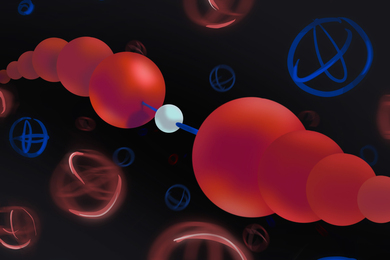A robot that didn't work until the 11th hour surpassed all expectations to beat out 19 opponents and take first place in a high school engineering design competition held at MIT last Friday.
Dubbed "Snowball's Chance" by its designers, the robot was equipped with a design modification that gave it the advantage in the end, but kept its young designers up late the night before the competition trying to get it to work.
"We didn't think it had a snowball's chance in hell," said team member Jesse Greene of Winter Park, FL, who, like the others, is a participant in this year's Minority Introduction to Engineering, Entrepreneurship and Science summer program (MITE2S) at MIT.
"Our design was too complex and we had to keep making adjustments," said Erute Mofoye of Tyler, TX, who previously participated in two national design competitions. "I thought that the design was good enough to win, but that we hadn't built it well enough."
Sybil Dessie of Glastonbury, CT was the third member of the winning team. "Ten Man" was the second-place robot. Other names included "Harmonic Discord," "Batmobile," "Big Poppa" and "God Help Us."
The tabletop robots had to collect eight three-inch yellow balls from a platform called No Man's Land and dump them into a bin while trying to push 16 smaller orange balls through a tunnel over to the opponent's side.
The multiple-round, 90-minute contest is patterned after the Design 2.007 competition. The 60 high school seniors were given a box of components including electric motors, wheels, springs, gear sets and pieces of wood, metal and plastic upon their arrival at MIT. Each team had three weeks to design and build a remote-controlled device.
The result: all the robots looked nearly identical, a little like small snow plows with adjustable arms on top. One student remotely "drove" the robot while another operated the arm.
SNOWBALL'S CHANCE
The advantage Snowball's Chance held was in its top arm and its team strategy.
While most of the other wheeled robots had an arm that either swung laterally from one side to bat at the balls or worked like a snow shovel to push the balls, the arm on Snowball's Chance could be raised, lowered, pushed and pulled.
The machine reached over the pile of balls to enclose them on four sides, then pulled them back onto a small platform on top, much like the mechanism that clears bowling pins from the alley. The robot then wheeled along, carrying the balls on top, and dumped its booty safely in the bin.
"Ours was really a radical idea: to drag the balls onto our base -- the top of our vehicle -- and carry them over to drop them in the bin," said Mr. Mofoye. "Our strategy was offensive rather than defensive."
"If we could get enough big balls in our bin we wouldn't have to worry about the little balls," said Mr. Greene. The larger balls represented positive points; the smaller were negative.
ACADEMIC INTENSITY
The MITE2S participants -- 29 boys and 31 girls hailing from 22 states, the District of Columbia and Puerto Rico -- are living at MIT for six weeks this summer. Their schedule includes 10 hours daily of classes, tutoring and study time.
In addition to the engineering design contest, the students will compete in the Enterprise Fair to show off their business plans for high-tech products -- complete with marketing schemes, financial projects and cash flow worksheets. The Enterprise Fair is scheduled for Wednesday, July 28 from 5:30-7:30pm in the lobby of Building E51 (the Sloan School).
This is MITE2S' 25th year of introducing underrepresented minority students to engineering and science at the university level. The program competes with about 400 other summer academic programs in the United States. Some 14 of these are designed specifically for minorities or other selected groups, and a mere eight of those concentrate on engineering, mostly for a week's duration.
This year, MITE2S received 624 applications for the 60 spots. All the students are admitted on full scholarship; food, housing and tuition are provided.
Like most MIT students, they arrive feeling a little unsure of themselves.
"I kind of expected to be the stupidest one here, and I'm not," said Nnennia Ejebe of Plymouth, MN. Her team's robot was called MAASA, for Multiple A**-kicking Apparatus and Swinging Arm ("I didn't name it," she said).
According to Karl Reid, executive director of special programs for the School of Engineering, nearly 74 percent of MITE2S participants go on to apply for admission to MIT. Of those, about 93 percent are accepted and 52 percent actually enroll. Twenty-nine of the 1998 MITE2S participants plan to enroll as MIT freshmen next fall.
"All of them go to the best schools in the country, and 80 to 90 percent end up going into engineering and science," said Mr. Reid.
A version of this article appeared in the July 14, 1999 issue of MIT Tech Talk (Volume 44, Number 1).





